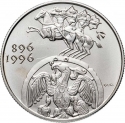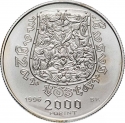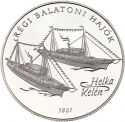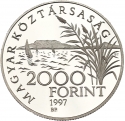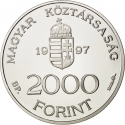You are about to finish your registration. Please check your mailbox (including spam folder). There should be a letter with a confirmation link. Check setting to make sure that your e-mail address is correct.
Send letter againDescription
The currency of Hungary is the forint (symbol: Ft; code: HUF), derived from the city of Florence where gold coins known as fiorino d'oro were first minted in 1252. In Hungary, the florentinus, later referred to as the forint, served as a gold-based currency from 1325 under the reign of Charles Robert, setting a precedent followed by several other nations. The introduction of the forint on August 1, 1946, played a pivotal role in stabilizing the Hungarian economy post-World War II.
Engraver: Sándor Sebestyén
Obverse

|
Depicts scattered and grouped illustrations of coins issued over the past fifty years, encompassing both forint and fillér denominations. Positioned in a semicircle at the top is an inscription reading "50th Anniversary of Forint", while at the bottom center, the engraver's initial (S) is displayed. ÖTVENÉVES A FORINT |
|---|---|
Reverse

|
Depicts a stylized flag with the Hungarian coat of arms positioned above it. Below the coat of arms, there is the stylized Anjou lily of Charles Robert's gold florin. The cross on the crown of the coat of arms is situated between the denomination and the inscription "FORINT". On the left side, slightly tilted at the edge, the engraver's initial (S) is visible, while on the right side, the mint mark (BP) and below it, the issuance year are displayed. The country name (Hungarian Republic) is depicted at the bottom. 2000 FORINT |
| Edge |
152 reeds |


